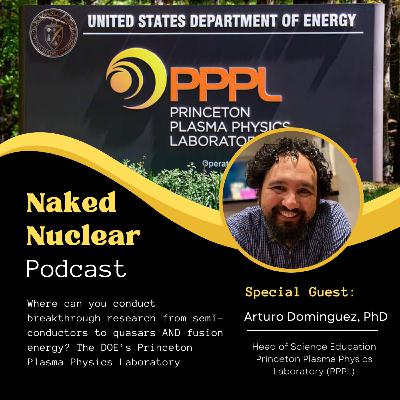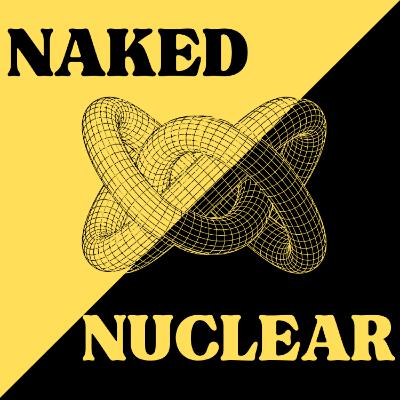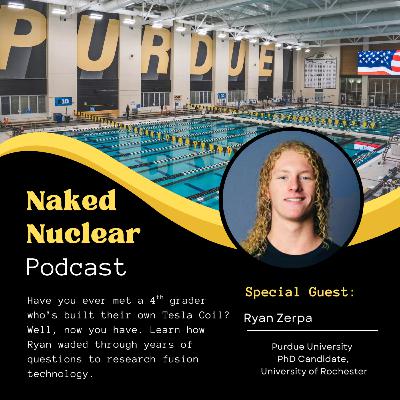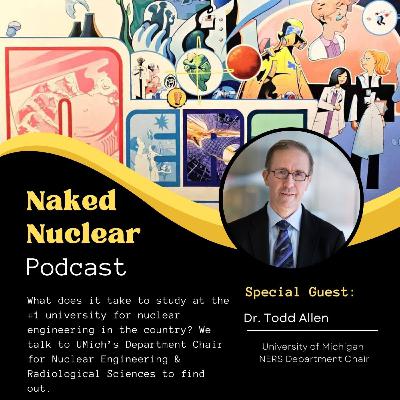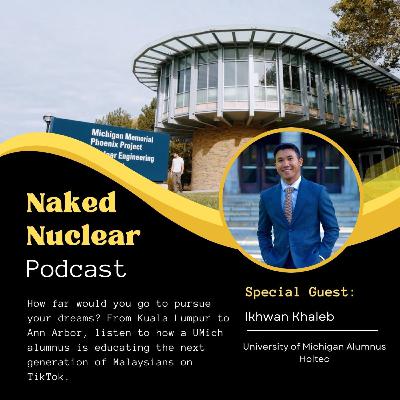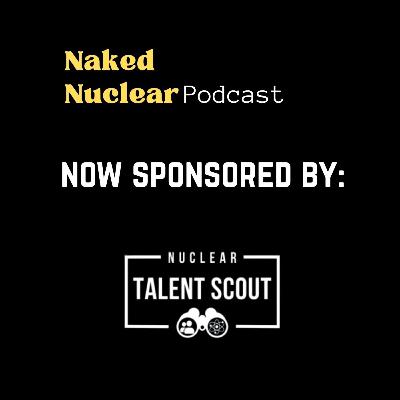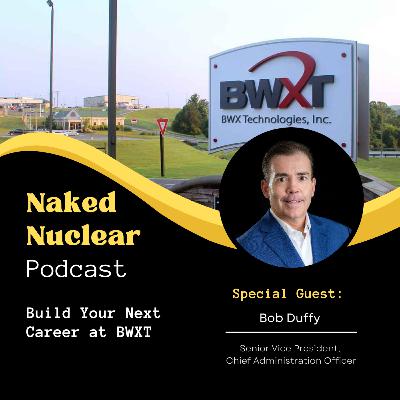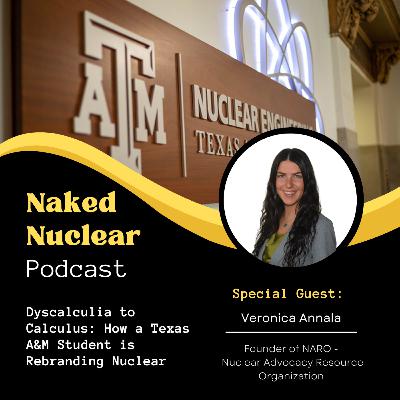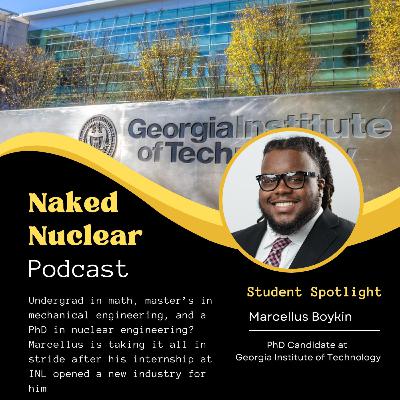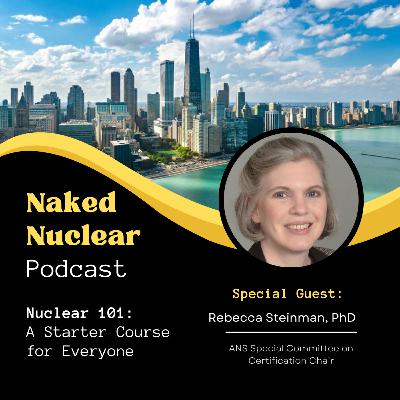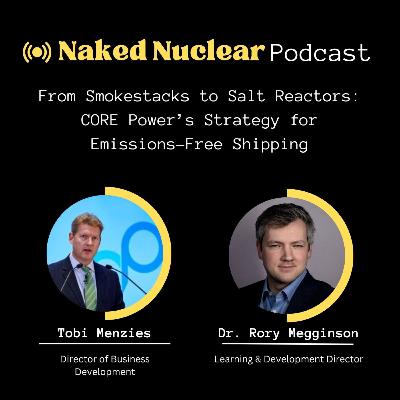Discover Naked Nuclear
Naked Nuclear

Naked Nuclear
Author: Danielle Allen
Subscribed: 5Played: 80Subscribe
Share
© Danielle Allen
Description
Ever wondered how nuclear energy works or what advanced nuclear technology really means? Naked Nuclear breaks down complex topics like nuclear reactors, fuel types, and emerging technologies into simple, accessible conversations. Whether you're a curious beginner or an energy enthusiast, we make the science behind nuclear power easy to understand so you can launch your career in the clean energy future. Tune in to strip down the fascinating world of nuclear energy—one atom at a time.
47 Episodes
Reverse
In this crossover episode between Naked Nuclear and Nuclearn’s The Future of Nuclear, we bring together two teams with different backgrounds but a shared philosophy: curiosity, collaboration, and the courage to try.Danielle comes from the world of storytelling and education; Phil comes from the world of digital nuclear operations and AI. One explores the industry through conversations and community, the other builds tools to help the industry work smarter. Together, they compare notes on culture, creativity, learning curves, and the very real value of taking the first step even when you don’t have all the answers.This episode is about nuclear — yes. But it’s also about the people building it, the mindset behind innovation, and why trying (and sometimes failing) is one of the most underrated skills in our field.Learn more about Nuclearn: Nuclearn.aiListen to 'The Future of Nuclear' Podcast here: https://nuclearn.ai/1569-2/
What exactly is plasma, and why are some of the world’s brightest minds betting on fusion energy to power our future? In this episode of Naked Nuclear, host Danielle sits down with Dr. Arturo Dominguez — Head of Science Education at the Princeton Plasma Physics Laboratory (PPPL) — to break it all down in plain language. From his own journey into plasma physics to PPPL’s groundbreaking research, Dr. Dominguez shares how fusion works, why it matters, and how students everywhere can get involved. We dive into PPPL’s free Introduction to Fusion and Plasma Physics course — a beginner-friendly, online class designed to make complex science accessible for anyone curious about the future of energy. Whether you're a college student, a career switcher, or just fusion-curious, this episode will give you a clear view into the fascinating world of plasma, research at Princeton, and how fusion could become a key player in the clean energy race. Check out more Resources:Intro to Fusion & Plasma Physics Course: https://www.pppl.gov/events/2023/introduction-fusion-energy-and-plasma-physics-courseScience Undergraduate Laboratory Internships (SULI): https://www.pppl.gov/science-undergraduate-laboratory-internships-suli Princeton Plasma Physics Lab (PPPL): https://www.pppl.gov More about Dr. Arturo Dominguez: https://www.pppl.gov/people/arturo-dominguez
What happens when you unleash more power than every power plant on Earth — for just a few billionths of a second?Welcome to After-Pop! — today, we’re diving into the Z Machine, the crown jewel of Sandia National Laboratories in Albuquerque, New Mexico. It’s the most powerful pulsed-power facility on the planet, capable of creating the same temperatures and pressures found inside stars, nuclear detonations, and planetary cores.In this episode, we’ll break down:Why the Z Machine was built — and how it keeps our nuclear stockpile safe without detonations.How the Z-pinch and “pulsed power” concept work — explained in plain English with real-world analogies.How researchers are using it to advance fusion energy, the same reaction that powers the Sun.Just how powerful 80 terawatts really is — and why shockwaves from each test can be felt miles away.What these micro-bursts of power teach us about the future of clean energy, defense, and physics at the edge of what’s possible.For a few nanoseconds, the Z Machine outshines the entire human race’s power output — a lightning strike made by human hands.Wanna READ MORE?Sandia’s official Z machine page (overview, how it works, research)https://www.sandia.gov/z-machine/Sandia’s fusion research pagehttps://www.sandia.gov/z-machine/fusion/Sandia’s energy research pagehttps://www.sandia.gov/z-machine/research/energy/The video you mentioned (Inside the Most Powerful X-Ray Source in the World)https://www.asminternational.org/news/videos/-/journal_content/56/10192/43932389/VIDEO/World Nuclear News article on First Light test on Zhttps://www.world-nuclear-news.org/articles/first-light-fusion-hails-success-of-initial-test-iAtlas Obscura page for general background & visual colorhttps://www.atlasobscura.com/places/the-z-machine-albuquerque-new-mexico
In this Student Spotlight, we trace how childhood curiosity—sparked by Nikola Tesla and MythBusters—led Ryan Zerpa from building a Tesla coil in grade school to pursuing fusion research. Ryan shares how he reframed a mostly-fission undergrad at Purdue Nuclear Engineering into a launchpad for fusion, what he learned working around pulsed-power experiments like Sandia’s Z Machine, and how Division I swimming forged the time-management and grit research demands. We unpack his plain-language way of explaining fusion (from “why energy transition” to “how plasmas are tamed with lasers and magnets”), then close with his next step: a PhD in high-energy-density physics at the University of Rochester (LLE)—and his advice for students to ask relentlessly and feed their curiosity.What you’ll learnWhy Tesla, fields, and hands-on tinkering pulled Ryan toward electromagnetism and fusionHow to turn a fission-heavy curriculum into fusion-useful skills (transport theory, fluids → plasmas)What pulsed-power/HEDP experiments aim to do and why nanosecond timing mattersThe student-athlete toolkit for research: discipline, recovery, and focused practiceA simple, audience-friendly way to explain fusion—and why storytelling in science mattersPractical advice for aspiring students: persistence beats perfectionSandia National Laboratories (SNL) — overview of the national lab and mission:https://www.sandia.gov/ Sandia National LaboratoriesZ Pulsed Power Facility (“Z Machine”) — Sandia’s pulsed-power/HEDP platform:https://www.sandia.gov/z-machine/ | About Z: https://www.sandia.gov/z-machine/about-z/ Sandia National Laboratories+1Purdue University — Nuclear Engineering — program home:https://engineering.purdue.edu/NE Purdue EngineeringRyan’s PhD site — University of Rochester, Laboratory for Laser Energetics (LLE)https://www.lle.rochester.edu/homepage/
What does it mean to be the #1 nuclear engineering program in the country?In this episode, we sit down with Dr. Todd Allen, department chair of the University of Michigan’s Nuclear Engineering & Radiological Sciences (NERS) program, to explore the history, mission, and future of a department that blends technical excellence with human-centered education. From submarines to art tunnels, this conversation offers a 360° look at what makes Michigan a true nuclear powerhouse.We cover:How a student-led movement after WWII became the Michigan Memorial Phoenix ProjectHow Michigan is preparing students for advanced nuclear innovationThe creation of a living memorial through art and engineeringUndergraduate and graduate experiences in one of the world’s most well-funded and research-rich departmentsThe Harper All Stars and how mentorship and scholarships are shaping the next generationThe OECD Global Forum on Nuclear Energy Science, Technology & Policy, hosted at Michigan this fall🔬 Michigan NERS Main Pagehttps://ners.engin.umich.edu🕊️ History of the Michigan Memorial Phoenix Projecthttps://ners.engin.umich.edu/academics/harperacademy/https://www.charlesharpercharities.org/harper-academy-4-future-nuclear-engineers🎨 Phoenix-Themed Tunnel Art Installationhttps://news.engin.umich.edu/2023/08/a-nuclear-engineering-education-inspired-by-art🧑🎓 Harper Academy All Stars (Charles Harper Charities)https://ners.engin.umich.edu/2024/09/16/harper-academy-all-stars-support-ners-researchhttps://www.charlesharpercharities.org/harper-academy-4-future-nuclear-engineers🌍 OECD Global Forum on Nuclear Energy Science, Technology & Policy – Hosted at U-Mhttps://ners.engin.umich.edu/2024/07/01/u-m-to-host-oecd-nea-global-forum-on-nuclear-energySubscribe, share, and leave a review to help us amplify the future of nuclear energy.Follow Naked Nuclear for more episodes that strip away the jargon and dive deep into the people, programs, and power behind nuclear science.
Ever wonder how tiny particles can power whole cities? In this After-Pop! we follow our previous episode with Ikhwan Khaleb and dive into the world of reactor physics — the science behind nuclear chain reactions, neutrons, and keeping everything safe and steady. What You’ll Learn in This Episode:What reactor physics actually means (and why it matters).The “life cycle” of a neutron, from birth to absorption.How scientists keep reactors balanced using criticality.What students study in reactor physics classes.Wanna learn more about reactor physics straight from the (peer-reviewed) source?Checkout these guides: Stacey, W. M. (2018). Nuclear Reactor Physics (3rd ed.). Wiley-VCH.Comprehensive textbook covering neutron life cycles, chain reactions, and reactor kinetics.Lamarsh, J. R., & Baratta, A. J. (2017). Introduction to Nuclear Engineering (4th ed.). Pearson.Widely used undergraduate text explaining the fundamentals of reactor physics in accessible language.Duderstadt, J. J., & Hamilton, L. J. (1976). Nuclear Reactor Analysis. Wiley.Classic reference on neutron transport, diffusion theory, and criticality.American Nuclear Society (ANS). (2021). Nuclear Science and Technology Basics.Introductory resource created by professional nuclear engineers.https://www.ans.org/nuclear-basics/U.S. Nuclear Regulatory Commission (NRC). (2022). Reactor Concepts Manual: Nuclear Physics Fundamentals.A regulatory training document explaining fission, chain reactions, and control systems.https://www.nrc.gov/reading-rm/basic-ref/students.html
Ikhwan Khaleb tells the story of moving from Malaysia to study in the University of Michigan’s NERS program, learning reactor physics in a second language, and turning TikTok into a platform for clear, visual nuclear education. We cover UMich coursework and labs, cultural adaptation, the grind of an international job search, and how engineering work at Holtec fuels his social media explainers.Links & ResourcesUniversity of Michigan — Nuclear Engineering & Radiological Sciences (NERS) — department homepage (program overview, news, people). ners.engin.umich.eduNERS Graduate Admissions & Applying to the Program (application materials, contact info for Grad Admissions). ners.engin.umich.eduNERS Labs & Research Groups (list of labs, facilities, and the Nuclear Power Simulation Lab / Ford Reactor VR resources). ners.engin.umich.eduNERS Graduate Program overview (MSE & PhD program descriptions and program expectations).
Breaking into the nuclear industry can feel overwhelming, from specialized certifications and security clearances to jobs that never even make it to job boards. In this episode of Naked Nuclear, Danielle shares an exciting new partnership with Nuclear Talent Scout, the premier recruiting firm focused exclusively on nuclear energy.Together, Naked Nuclear and Nuclear Talent Scout are planting the seeds for the next generation of the nuclear workforce. From free resources at nucleartalentboost.com to insider access to unlisted job opportunities, this partnership is all about connecting YOU to meaningful careers in nuclear.What You’ll Learn in This Episode:Why the nuclear workforce is in such high demand right now (hint: retirements + new builds + advanced reactors).The hidden challenges of nuclear hiring — and how recruiters like Nuclear Talent Scout make a difference.How Nuclear Talent Boost offers free training, cheat sheets, and coaching for those looking to pivot into nuclear.What “Industry Feature Fridays” are and how they’ll spotlight niche experts passing knowledge to the next generation.Why working with Nuclear Talent Scout can give you access to exclusive jobs, resume support, and direct connections to hiring managers.Resources & Links:Register for free career resources: nucleartalentboost.comLearn more about Nuclear Talent Scout: nucleartalentscout.comConnect with Danielle on LinkedIn: https://www.linkedin.com/in/danielleallen-nuclearContact Danielle: danielle@nakednuclear.comAnd if you’d like to be featured on a future episode, send Danielle a message — don’t forget to share your background and your favorite dessert! 🍰
What makes someone stay at the same company for decades — or even generations?In this episode of Naked Nuclear, we sit down with Bob Duffy, Senior Vice President and Chief Administrative Officer of BWX Technologies (BWXT), to explore what’s behind the company’s incredibly low attrition rate, its investment in early talent, and how it’s preparing for the next generation of nuclear professionals.Bob shares how BWXT is going beyond traditional hiring — building weld schools in high schools, ramping up internships, offering internal growth pathways, and supporting students through scholarships and tuition reimbursement. We also discuss how you can stand out in the hiring process and what kinds of roles are most in demand right now — from engineers to machinists to project managers. With over 700 job openings (at the time of recording) you've gotta see what's cooking at BWXT. Apply to work at BWXT: https://www.bwxt.com/careers Learn more about BWXT: https://www.bwxt.comLearn more about Welding School in Mt. Vernon, Indiana https://investors.bwxt.com/news-releases/news-release-details/bwxt-opens-welding-program-mount-vernon-high-school BWXT in the Newshttps://investors.bwxt.com/news-events/news-releases 🎓 2025 BWXT STEM Scholarship Winners:Haris KhanElla SchmutzNeev ShahCorine GlicksteinLondon Puckett
On this episode, we dive into the power of curiosity—how simple questions can spark revolutions in science, technology, and society. Inspired by a roadside observation, we explore why cultivating curiosity is critical at every level of society, from national parks to apprenticeships, and why funding the “discovery phase” of science pays off in ways we can’t always predict.While it’s often said that monarchs avoid the Great Lakes as if skirting a long-gone mountain, this is a myth. Monarchs use sun compasses, circadian rhythms, and favorable winds to navigate—reminding us that curiosity often begins by questioning the stories we tell ourselves.Why curiosity—not just knowledge—drives innovationThe role of safe, well-funded environments in enabling groundbreaking discoveriesHow modern technology is tied to the curious minds of legendary scientistsPractical tips for fostering curiosity in your own lifeScientists who Researched their Curiosities Lise Meitner – Her insights into nuclear fission led to carbon-free nuclear energy and medical isotope production.Marie Curie – Her pioneering work on radioactivity laid the foundation for radiation therapy, saving millions of lives.Enrico Fermi – His research on neutrons and chain reactions paved the way for nuclear reactors and nuclear medicine diagnostics.How to Spark Curiosity Notice the unfamiliar on your daily commute and learn what it is.Pick a word you don’t know and find its meaning.Learn something new from someone in a different generation.
You don’t have to be a math genius to change the world — just ask Veronica Annala. In this inspiring Student Spotlight, Danielle sits down with Veronica, a recent Texas A&M nuclear engineering graduate and founder of the Nuclear Advocacy Resource Organization (NARO). Diagnosed with dyslexia and dyscalculia, Veronica shares how she built her own study systems, cried through calculus — and still emerged as a leader in the next generation of clean energy advocacy.They unpack the birth of NARO, how a trip to Antarctica sparked her nuclear “a-ha” moment, and why Veronica is now pursuing an MBA to scale the movement even further. From grassroots posters to national policy, this conversation is about curiosity, audacity, and rewriting the narrative around who belongs in STEM.Overcoming dyslexia and dyscalculia in engineeringThe impact of great teachers and inclusive classroomsFounding NARO and building student-led nuclear movementsVeronica’s decision to pursue an MBA for nonprofit leadershipAdvice for students who feel like they don’t “fit the mold”More Resources: Get involved with NARO “Why a Texas A&M Student Went Nuclear on College Gameday” – U.S. DOE Read NARO Papers – TRIGA ReactorsWebsite: nuclearadvocacy.orgInstagram: @nuclearadvocacyLinkedIn: NARO on LinkedIn
Thanks for tuning in. In this episode, Danielle highlights four in-demand skilled trades in the nuclear energy industry that require months to years of training instead of a doctorate. For each trade, we cover:Commercial DivingSpecialized HAZMAT diving in irradiated environmentsHistorical roots, real-world challenges, and a “day in the life”Training pathways, costs, salary ranges, and union vs. non-union optionsConcrete MasonryBuilding and finishing ultra-low-permeability containment structuresApprenticeships vs. trade-school certificatesTypical project durations, pay, and professional bodiesPipefittingInstalling high-precision coolant, steam, and service pipingNCCER’s 16-module curriculum and UA apprenticeshipsOutage vs. new-build work, salary insights, and key associationsHVACMaintaining clean-room and safety-critical climate systems3–5 year apprenticeships, technical diplomas, and NATE/EPA certificationsDay-to-day tasks, pay scale, and union/open-shop routesRESOURCES Divers Institute of Technology (World Nuclear Diving module):https://diversinstitute.edu/world-nuclear-diving/Pro Diver School: https://prodivertc.com Association of Diving Contractors International (ADCI): https://www.adc-int.org/Diver Certification Board of Canada (DCBC):https://www.divercertification.com/more-info/careers-in-diving/ American Concrete Institute (ACI): https://www.concrete.org/International Masonry Institute (IMI): https://www.imiweb.org/NCCER Pipefitting Craft Catalog: https://www.nccer.org/craft-catalog/pipefitting/United Association (UA): https://ua.org/pipefitters/American Society of Plumbing Engineers (ASPE): https://www.aspe.org/EPA Section 608 Certification: https://www.epa.gov/section608North American Technician Excellence (NATE): https://www.natex.org/HVAC Engineer Job Description: https://altea-energy.com/sheets/hvac-engineer-nuclear-energy-jobs/
After-Pop! Episode: What the Heck is a Hot Cell?In this After-Pop! Danielle breaks down the mysterious world of nuclear hot cells—shielded enclosures that let scientists safely handle some of the most radioactive materials on Earth. From spent nuclear fuel to life-saving radiopharmaceuticals, hot cells are the unsung heroes of nuclear science and medicine.✨ What We Cover:What hot cells are and why they matterHow they look and operate (hello, robotic arms!)The different types of hot cells: standard, GMP, mini cells, and mobileThe crucial role they play in nuclear fuel reprocessing, reactor safety, medical isotope production, and moreA look ahead at innovations in automation and training🎧 Listen to our full episode with Marcellus Boykin, where we first touched on hot cells and other nuclear workforce innovations: [LINK TO EPISODE]🔗 Learn more about hot cells:The Buzz on Hot Cells – Westinghouse BlogVon Gahlen Hot Cells OverviewGlobalSpec: Hot Cells ExplainedGot questions about hot cells or other nuclear tech? leave a comment or follow us on LinkedIn
In this episode, we continue Season 2 with our second Student Spotlight, featuring Marcellus Boykin, a PhD student in nuclear engineering at Georgia Tech. Marcellus shares his journey from math major and football player to shielding sensors in hot cells at Idaho National Lab, presenting at ANS, and navigating imposter syndrome in graduate school.Learn how he went from: math --> mechanical engineering --> nuclear engineering Links & Resources:Learn more about the GEM FellowshipExplore Georgia Tech’s Nuclear Engineering ProgramFind internships at Idaho National LaboratoryListen & Subscribe: Follow Naked Nuclear on your favorite podcast platform and stay tuned for more student spotlights, industry insights, and the future of nuclear energy.
In this episode of Naked Nuclear, Danielle sits down with Dr. Rebecca Steinman, PhD and the American Nuclear Society (ANS) to explore Nuclear 101—a hands-on, introductory course designed not just for engineers, but for anyone curious about the nuclear energy industry. Whether you're a welder, museum curator, communicator, or career changer, this episode reveals why now is the perfect time to step into nuclear. We also explore ANS's broader efforts in workforce development, including the Certified Nuclear Professional (CNP) certificate.The Nuclear 101 course was created to make the industry more accessible and train newcomers beyond traditional four-year degrees.Course attendees have included museum staff, communicators, welders, and logistics professionals—proving the nuclear workforce is broader than you might expect.ANS is building out online versions of Nuclear 101 and future offerings like “Nuclear 102” and “Radiation Protection Basics.”The Certified Nuclear Professional (CNP) certificate is a new credential for professionals without nuclear degrees to showcase their understanding of the field.All of these programs were developed by volunteers across the industry—from utility experts to regulatory professionals and early-career engineers.Helpful links: 🔗 Nuclear 101 Course Info & Registrationhttps://www.ans.org/nuclear101/🔗 Certified Nuclear Professional (CNP) Certificate Programhttps://www.ans.org/credentialing/cnp/🔗 ANS Education & Training Portalhttps://www.ans.org/education/🔗 ANS Annual Conference (Chicago, June 15–19, 2025)https://www.ans.org/meetings/Loved the episode? ❤️Rate the show, leave a review, subscribe to Naked Nuclear, and share this episode with someone curious about the nuclear field. 👀 Follow us @NakedNuclear for upcoming episode drops and behind-the-scenes content.
In this After-Pop!, host Danielle explores the rise of commercial nuclear propulsion and how companies like CORE Power are reimagining the future of maritime shipping. Unlike military nuclear propulsion systems, these next-gen commercial systems are designed to be safe, scalable, and fully integrated with international safeguards.This episode covers:The technical differences between military nuclear propulsion and commercial nuclear electric propulsionWhy advanced reactors like molten salt designs are ideal for maritime applicationsWhat Emergency Planning Zones (EPZs) are and how they apply to floating reactorsThe roles of the International Maritime Organization (IMO) and International Atomic Energy Agency (IAEA)Why the first nuclear-powered trade routes will likely be limited to specific corridorsResources and Further ReadingWorld Nuclear Association – Nuclear-Powered Ships Overviewhttps://world-nuclear.org/information-library/non-power-nuclear-applications/transport/nuclear-powered-ships.aspxCORE Power – Maritime Nuclear Propulsionhttps://www.corepower.energy/maritime-applications/nuclear-propulsionCORE Power – Security and Safeguardshttps://www.corepower.energy/standards-and-regulations/security-and-safeguardsCORE Power – Embracing Nuclear Propulsion in Ports (Interview)https://www.corepower.energy/news/interview-embracing-nuclear-propulsion-in-portsIEEE Spectrum – Can Nuclear Power Cargo Ships Clean Up Shipping?https://spectrum.ieee.org/nuclear-powered-cargo-shipBusiness Norway – The Future of Nuclear-Powered Shipshttps://businessnorway.com/articles/the-future-of-nuclear-powered-ships
Nuclear-powered cargo ships might sound like science fiction—but CORE Power is making them a science reality. In this episode of Naked Nuclear, Danielle sits down with Tobi Menzies and Dr. Rory Megginson from CORE Power to explore how molten chloride fast reactors (MCFRs) and floating nuclear power plants (FNPPs) could transform global shipping.We dive into the engineering, the policy, the people—and the programs—needed to build a clean maritime future. From international emissions policy to student research programs to training industry professionals, CORE Power isn’t just designing reactors. They’re designing the entire ecosystem.00:00 – Introduction: From Steam to Salt Reactors03:10 – Why Nuclear Shipping? Global Trade and Climate Math08:30 – What Is a Molten Chloride Fast Reactor (MCFR)?15:00 – Floating Nuclear Power Plants (FNPPs) Explained18:20 – Lava Lamps and Fast Neutrons: MCFR Recap19:30 – Why Shipping Needs a Nuclear Upgrade23:00 – The Academic Resource Program: Supporting Student Research26:10 – Internships and Entry Paths into Nuclear Maritime Careers28:20 – The Convoy Program: Training the Industry Itself34:30 – From Shipowners to Port Authorities: Who Needs to Learn?39:00 – CORE Power’s Vision for 2040 and Beyond42:00 – How to Get Involved with CORE PowerCORE Power website: https://www.corepower.energyAcademic Resource Program info:https://www.corepower.energy/academic-resourcesConvoy Corporate Training Program: https://www.corepower.energy/convoyNuclear Shipping & FNPP Overview: https://www.corepower.energy/maritime-applications/nuclear-propulsion📬 Sign up for CORE Power’s newsletter: https://www.corepower.energy/contact🔗 Resources & Links:IMO 2023 Strategy on Greenhouse Gas Reductions:https://www.imo.org/en/OurWork/Environment/Pages/2023-IMO-Strategy-on-Reduction-of-GHG-Emissions-from-Ships.aspx NEMO Website:https://www.nemo.ngo/missionSome Light Reading on Nuclear Powered Ships:https://world-nuclear.org/information-library/non-power-nuclear-applications/transport/nuclear-powered-ships
In this episode, we dive into the world of scholarships, grants, and fellowships available for students at various academic levels and fields, particularly within the nuclear sector, STEM, and the energy world. We dispel the myth that scholarships are only for top high school students, revealing opportunities for diverse groups including veterans, career changers, and students pursuing trade and two-year degrees. There's practical advice on how to successfully apply for these scholarships, emphasizing the importance of storytelling, organization, and broad application strategies. A complete list of all of the scholarships and opportunities can be found on our blog at nakednuclear.com
In this After-Pop, Danielle breaks down Boron Neutron Capture Therapy (BNCT) — a precision cancer treatment that uses nuclear science to selectively target tumors while sparing healthy tissue.You’ll learn:– What boron is and how it works inside cancer cells– How neutron beams are made (yes, actual beams of neutrons!)– What “epithermal neutrons” are and why they matter– Who could benefit from BNCT and why it’s gaining traction again– How newer technologies are making BNCT more accessible worldwideWhether you're a curious student, a medical science nerd, or just someone who loves smart bombs for tumors, this one’s for you.Key Takeaways: --BNCT is a two-part therapy using boron and neutron beams to destroy cancer cells with incredible precision.--Epithermal neutrons are ideal for this process because they penetrate tissue effectively but still slow down enough to interact with boron.--The particles created from the boron-neutron reaction only travel about the width of a single cell — keeping the damage ultra-local.--BNCT is gaining renewed interest due to better boron delivery agents and compact accelerator-based neutron sources.🔹 It’s especially promising for hard-to-treat cancers like glioblastomas, melanomas, and head and neck tumors.Want to go deeper? Here are the sources referenced in this episode:Barth RF, Mi P, Yang W. (2018). Boron neutron capture therapy of cancer: current status and future prospects. Journal of Clinical Oncology and Cancer Research. PMC articleIAEA (2020). Current Status of Neutron Capture Therapy. IAEA Human Health Series. IAEA PDFMiyatake S, et al. (2021). Boron neutron capture therapy: Clinical experiences and future challenges. Frontiers in Oncology. Frontiers article
What do candlelit homework, career pivots, and global nuclear leadership have in common? Dr. Fiona Rayment.In this episode, Danielle speaks with internationally respected nuclear chemist and engineer Dr. Fiona Rayment about her early experiences with energy insecurity, her path through a diverse and powerful career, and the future of workforce development in the nuclear industry.Together they explore:– Why your first role doesn't have to be your forever one– How to tell when you've lost your spark (and how to get it back)– The surprising variety of roles across the nuclear sector– What “Destination Nuclear” is doing to bust old stereotypes– Why gender diversity isn’t just a nice-to-have — it’s critical– Regulatory innovation and how to accelerate new technologies responsiblyThis episode is packed with real-world insights for anyone navigating their own career journey, mentoring others, or building tomorrow’s energy workforce.Resources & Links:🔗 Destination Nuclear → https://www.destinationnuclear.com🔗 Nuclear Skills Delivery Group (NSDG) → https://nuclearskillsdeliverygroup.com🔗 Learn more about Dr. Fiona Rayment → https://nuclearinst.com/dr-fiona-rayment-obe Wanna learn more about historical women in science? https://obamawhitehouse.archives.gov/women-in-stem



